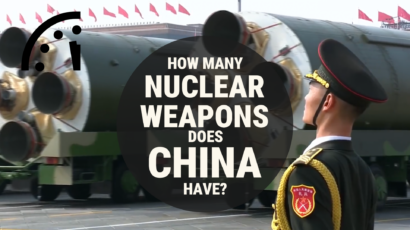Five reasons that Russia’s nuclear exports will continue, despite sanctions and the Ukraine invasion. But for how long?
By Marina Lorenzini, Francesca Giovannini | May 17, 2022
 Russian President Vladimir Putin participates via video link in a ceremony to launch the construction of a third reactor of the Turkish nuclear power plant built by Russia's energy giant Rosatom, in Moscow on March 10, 2021. (Photo by ALEXEY DRUZHININ/SPUTNIK/AFP via Getty Images)
Russian President Vladimir Putin participates via video link in a ceremony to launch the construction of a third reactor of the Turkish nuclear power plant built by Russia's energy giant Rosatom, in Moscow on March 10, 2021. (Photo by ALEXEY DRUZHININ/SPUTNIK/AFP via Getty Images)
By many measures, Russia’s state-controlled nuclear energy company, Rosatom, has primacy in the global nuclear energy market. At any given moment, the firm provides technical expertise, enriched fuel, and equipment to nuclear reactors around the world. The Russian invasion of Ukraine and, more acutely, the Russian military’s dangerous actions at the Zaporizhzhia nuclear power plant and in the Chernobyl exclusion zone have many countries rethinking their dependence on Russian nuclear products and searching for alternatives. Additionally, the ensuing global effort to cripple Russian access to international markets calls into question the viability of current contracts, government licensing, and financial instruments involved in Russia’s nuclear exports.
Concurrently, the invasion has highlighted the lack of energy source diversification across Europe. Headlines have focused on how several European countries decided to phase out or delay plans to build new nuclear power plants in the wake of the 2011 Fukushima-Daiichi disaster and, instead, increase imports of Russian oil and natural gas to feed their electric grids’ baseload needs. Now, in response to the sudden European effort to minimize dependence on Russian imports, the United States has sent tankers of liquefied natural gas (LNG) to European ports. Additionally, the United States and partners are releasing a round of oil from their strategic stockpiles to stabilize market prices. For oil and natural gas supplies to Europe, there are some immediate alternatives available. However, for nuclear power plants, swapping in alternative supplies is causing serious dilemmas and could lead to stranded assets.
Disdain for Russia’s actions in Ukraine and current sanctions related to the invasion will ultimately exact costs from the Russian nuclear industry, but Russia’s dominance in the nuclear energy market will likely endure in the short term for five main reasons.
US and EU reluctance to apply sanctions specifically to the Russian nuclear energy sector. Current US sanctions heavily target Russia, but they are not broad, geography-based designations, like the sanctioning approaches to Iran and North Korea, which target all persons and entities connected to those countries. Without a geography-based designation, various legal authorities currently form a patchwork of sanctions that target Russia in some way—but also, in practice, allow some forms of trade to occur, namely in the energy sector.
Despite the Biden administration’s initial signals, Rosatom has yet to be sanctioned explicitly. On March 8, President Biden issued an executive order focused on inhibiting investment in the Russian energy sector. While one section of the order (“new investment in the energy sector in the Russian Federation by a United States person”) may arguably include the nuclear energy industry, the Biden administration has not yet specifically targeted Russia’s mineral, fuel, or equipment exports in the United States and around the world related to nuclear power plants. Plus, the long-term contracts currently in place are not in immediate jeopardy since the executive order focuses on “new investment.”
The European Union has demonstrated similar patterns. Politico reported at the end of April that five EU diplomats disclosed that the EU is mulling placing sanctions on uranium imports from Russia. This follows a call on April 7 from members of the EU Parliament for additional punitive measures, including “an immediate full embargo on Russian imports of oil, coal, nuclear fuel, and gas.” The call more explicitly mentions nuclear and would impact current and future contracts, if enacted in its current form. That being said, no such action has yet taken place.
US and EU reliance on Russian fuel. Upon further examination of nuclear fuel supplies, the hesitation to enact an embargo becomes clear. According to the US Trade Commission, in 2019 Russia was the 20th-largest supplier of imported goods to the United States. But, the most valuable set of imported goods, sitting at a $13 billion valuation, was mineral fuels, including uranium and enriched nuclear fuel. In 2020, imports of Russian uranium accounted for 16 percent of uranium purchases for US nuclear power plants, according to the Energy Information Administration. This is just one example of how the United States’ nuclear energy industry is greatly intertwined with Russian products.
During her confirmation hearing, a senior adviser in the US Energy Department, Kathryn Huff, told the Senate’s Energy and Natural Resources Committee that “[w]e need to build out capacity for a Western alternative for the Russian component of the uranium market, including conversion and enrichment capacity. There is no question in my mind that we will continue to focus on uranium as an incredibly important fuel.”
While the Energy Department may have the desire to wean US nuclear power from Russian supplies, immediate cost-effective and quick alternatives are not available on the market. Replacing Russia’s uranium and related nuclear fuel services alone would require government spending of $1 billion or more, Huff stated. Europe faces a similar quandary. The EU imports almost all its uranium from outside the bloc. And, about 20 percent comes from Russia, making the country the second-largest supplier to the EU after Niger.
As of this writing, the price of uranium sat at close to $50 per pound and peaked at $65 in mid-April, a significant jump from around $26 per pound in August 2021. Increasing the scarcity of uranium supply by sanctioning such products could lead to a further shock to electric grids at a moment when prices of other sources of energy are also recalibrating due to market volatility.
In addition to legacy fuel sources, advanced reactor demonstrations expected to come online around 2028 require high-assay, low-enriched uranium (HALEU), which is enriched to contain a higher percentage of the fissile uranium 235 isotope than commercial nuclear power reactors now use. Russia is currently the singular viable commercial supplier globally of HALEU, and other firms look to be years away from readily providing such fuel. It wasn’t until 2021 that Centrus Energy Corporation became the only licensed HALEU production facility in the United States. The Department of Energy has announced that the company is on track to produce fuel by this summer.
To address the nuclear fuel situation, on April 7, US senators Joe Manchin and Jim Risch introduced the International Nuclear Energy Act of 2022. Among other goals, the bill aims to create a Nuclear Fuels Security Initiative that would reduce and eventually eliminate reliance on Chinese and Russian nuclear fuel. If this bill passes, then the US domestic nuclear industry may be better positioned to absorb the consequences of a ban on Russian nuclear products and, in turn, also act as a global supplier. But even if passed and signed into law, this initiative may take several years to be realized.
Most destination countries continue to import nuclear products from Russia. Except for a few circumstances, most countries and companies are continuing their contracts with Russian nuclear companies, whether they are facing public pressure to decouple themselves from the Russian economy or not. These contracts involve many aspects of nuclear power plant construction, operation, and maintenance.
Fuel delivery. For instance, Sweden’s nuclear energy company Vattenfall AB, announced on February 24 that it would not place new orders with Russian companies for nuclear fuel until further notice. In the announcement, the President and CEO Anna Borg noted that the firm has secured alternative deliveries of nuclear fuel. Vattenfall sources its uranium supplies from Australia, Canada, Kazakhstan, and Namibia. So, the decision to not place new orders with Russian companies did not create a significant disruption for procurement of fuel.
Government licensing and project finance. Since the Russian invasion of Ukraine, Finnish officials have questioned the viability of the planned construction of the Hanhikivi nuclear power plant. The dispute hinged on whether the government would grant a construction permit. A Finnish-Russian consortium (called Fennovoima) commissioned the plant, in which Finnish stakeholders such as Outokumpu, Fortum, and SSAB own two thirds, with Rosatom’s subsidiary RAOS Voima holding the remainder. Fennovoima had expected to obtain a construction license from the government by this summer to build the 1.2-gigawatt (GW) reactor, while construction was expected to begin in 2023. In a statement, Rosatom and RAOS Project stated that they would continue to fulfill their obligations from signed agreements and contracts relating to the Hanhikivi I project. On May 2, Fennovoima terminated the existing contract with RAOS, demonstrating a willingness to absorb financial costs. However, such costs were rather minimal in comparison to the consequences that could have been incurred if the plant were already operating.
Other countries and/or companies may not be in the position to accept the costs of quickly pivoting away from Russian provisions. In fact, even NATO members like Slovakia, Hungary, and Turkey are continuing their operations with Rosatom. These countries house Russian-made nuclear reactors, for which there is no authorized nuclear fuel alternative to the Russian supply, and terminating a partnership with Rosatom could mean temporarily halting operations at the facility.
Mining and fuel delivery. While Slovakia has said that it has enough nuclear fuel to last through the end of 2023, a ban on Russian imports would be an impending challenge. “This is very concerning as we are 100 percent dependent on Russian nuclear fuel deliveries from the company TVEL,” said Karol Galek, Slovakia’s state secretary for energy in the Ministry of Finance. Slovakia has notable uranium deposits in east of the country. But when Canada’s Tournigan Energy showed interest in investing in mining uranium, citizens strongly protested in 2006 and again in 2013. According to amendments in 2010 to Slovakia’s Geological Act, citizens of nearby villages can reject an application for uranium exploration. Plus, even if citizens agreed or the government were to further amend the law, it could take several years to start mining operations.
Fuel delivery, loan disbursement, and facility expansion. In Hungary, the challenge goes beyond the fuel itself. Even after opposition parties called for Prime Minister Viktor Orbán to cancel a roughly 12.5 billion euro ($13.84 billion) deal with Rosatom, Foreign Minister Peter Szijjarto announced on March 2 that no such action would take place. The deal is set to build another two reactors at the Paks plant to replace the capacity of the current units. The two current reactors are set to be shut down between 2032 and 2037. The existing 2-gigawatt plant, consisting of two Russian-made VVER reactors, accounts for about half of Hungary’s electricity generation and was largely financed by a Russian state loan. In fact, even in the thick of the Ukraine war, on April 7, Hungary received the first shipment of nuclear fuel for Paks nuclear plant from Russia.
In Hungary, not only is Paks reliant on Russian nuclear fuel, but the country also already has contracts in place to expand the facility and finance the project with Russia. This circumstance brings to the fore another traditional strength of the Russian nuclear industry: state-backed financing. For years, Russian companies have out-maneuvered competitors and secured lucrative deals due to their state-backed financing offerings. Many other companies—including Framatome, Mitsubishi Heavy Industries, Siemens, and Westinghouse—typically require robust financial guarantees, partnership arrangements, and power purchase agreements to satisfy their own corporate business standards. Not only is the Paks plant already fit to comply with Russian products, but no other nuclear company or state is likely willing to match the Russian offer.
Russia offers extensive and generous financing structures. In ways not fully realized in Hungary yet, the Akkuyu nuclear power plant in Turkey demonstrates the aggressive financing capacities embedded within the Russian nuclear export strategy. Unlike in Finland, Hungary, Slovakia, and the United States, Turkey’s partnership with Russia involves the ongoing construction of an estimated $22 billion nuclear power plant. (Rosatom would build four VVER-1200 generation 3+ reactors, producing 1.2 gigawatts each.) This plant is set to provide 10 percent of Turkey’s annual electricity needs, with the first reactor undergoing installation and scheduled to be online in 2023, the 100th anniversary of the founding of the Republic of Turkey, with the other three units to follow by 2026. Even with the ongoing war in Ukraine, on March 16 Rosatom delivered the main components of a turbine plant, including a stator, turbine generator rotor, and low-pressure cylinder. With such a lucrative and symbolic deal in process, Turkey is unlikely to pull the plug.
The Akkuyu plant was made possible by an innovative Russian creation previously unseen in the nuclear industry: the build-own-operate investment model. After decades of unfruitful efforts to attract foreign nuclear power companies to build Turkey’s nuclear energy infrastructure, the Turkish government took a new approach in May 2010—direct talks between the Russian Federation and the Republic of Turkey that led to an intergovernmental agreement within the same year.
The “build” step of the model is made possible by the Russian-established project company in Turkey called the Akkuyu Nuclear Joint-Stock Company, with stakeholders consisting of Russian companies: Rosatom Energy International JSC (74.915 percent), Rosenergoatom JSC (21.948 percent), Atomstroyexport CJSC (2.267 percent), Inter RAO UES JSC (.820 percent), Atomtechenergo JSC (.025 percent), and Atomenergoremont JSC (.025 percent). Through the stakeholders, Russian banks provide loans to the Akkuyu Nuclear Joint-Stock Company. And some of the banks haven’t fared so well under the current U.S. sanctions regime.
To name a few: In 2021, Sberbank announced it would provide a loan of $800 million for a period of seven years to construct the four units at the Akkuyu plant. On February 24, the Biden administration placed sanctions on Sberbank, Russia’s largest state-owned bank, which holds a third of all bank assets in Russia. In early May, European Commission President Ursula von der Leyen announced that the EU will move to cut Sberbank from the SWIFT international payments system.
Sovcombank has also been involved in Rosatom’s construction of Turkey’s Akkuyu plant, announcing $300 million in loans in March 2021. A year later, the company and executives were put on the sanctions list administered by the US Treasury’s Office of Foreign Assets Control. Also, as of March 12, Sovcombank will no longer have access to the Belgium-based SWIFT financial messaging service. Undoubtedly, sanctions will impact the overall financial health of the banks and their ability to continue operations as before.
But it remains unclear, based on information in the public press, how the banks have adapted to the current sanctions. Will they be able to fulfill the announced loans in full? What actions are the countries and companies involved taking to shield themselves from potential exposure to the US sanctions regime? Will companies or countries seek a sanctions waiver from the United States or EU to continue this specific kind of cooperation? Beyond those questions, it also remains unclear to what extent the Biden administration or the EU will prioritize pursuit of sanctions violations on Slovakia, Hungary, or Turkey for their current cooperation with Russian nuclear entities and associated financing vehicles. Only time will tell how sanctions will directly or indirectly impact the banks’ ability to deliver on the project finance agreements.
In the event of a halt to construction at the Akkuyu site, whether due to bankruptcy or an import embargo, Turkey would inherit a serious stranded asset problem.
No other supplier is prepared to quickly operate a Russian facility. To date, India has not imposed any sanctions against Russia. Nonetheless, there is great debate on the extent to which secondary sanctions could affect India. India hosts two Rosatom-built reactors (Kudankulam 1 and 2) that are connected to the electric grid and a desalination plant. Rosatom provides the enriched fuel for this site, and construction is underway for an additional four reactors on the site. If the connection to Rosatom were to be severed, who would supply spare parts for the two operating reactors, which up to now came from Rosatom? Will operation of those two plants cease, at least for a while? And how would work on the four new reactors go forward? If ties with Rosatom were to be cut, the Indian reactors could well become stranded assets. Iran’s Bushehr reactor provides a historic example of just how costly such orphaned nuclear facilities can become.
In 1975, West Germany’s Kraftwerk Union AG signed contracts to build a ‘turnkey’ nuclear power plant and deliver nuclear fuel for the reactor units at Iran’s Bushehr nuclear power plant. But in 1979, construction was interrupted by the fall of the Shah and the Islamic Revolution. Such political conditions, followed by the Iran-Iraq War (1980-1988), dissuaded Kraftwerk Union from continuing operations. It wasn’t until 1995 that Iran could solidify a renewed effort on the reactors, via a contract for approximately $800 million with the Russian Federation Ministry for Atomic Energy (Minatom) to complete Bushehr’s Unit 1, a Russian VVER pressurized water reactor. Because of a variety of difficulties in meshing the work done under the German contract with the Russian reactor, the first Bushehr unit didn’t reach 100 percent power generation capacity until August 2012—37 years after the original contracts were signed.
The Bushehr site suggests just some of the difficulties that any number of Russian built, operated, or supplied reactors could face, if sanctions were to force plants to cut ties with Rosatom and/or Russian financing vehicles. The facilities could then also become stranded assets, a source of millions of dollars in lost revenues, to say nothing of the secondary impacts related to the delay in provision of electricity to surrounding populations. Given those impacts, it is likely that most countries with Russian reactors will continue working with Rosatom in the near term, and perhaps longer.
Will Rosatom be able to reach new nuclear agreements? In the short term, the Russians will likely retain most of their nuclear-related commercial agreements and remain a strong player in the global nuclear market. Finland and Sweden seem to be outliers in the field. Still, the political pressure is mounting, and countries may put forth the necessary investments in the coming years to disentangle themselves from Russian provisions. Future long-term contracts with Russian entities may no longer be seen as vital.
Given the political environment and potential loss of revenue streams, Russia has attempted to flex its muscles. To bolster its own currency, it is possible that Russia could sway countries to develop mechanisms to pay in rubles, as we have seen in the oil and natural gas market. Plus, Russian Deputy Prime Minister Alexander Novak announced that Moscow is considering banning exports of Russia uranium to the United States in retaliation for sanctions. Would Moscow do the same for the EU bloc or any country speaking out against Russian atrocities in Ukraine?
Nonetheless, if Russia cannot continue to fulfill generous loans as sanctions shrink Russian reserves, Rosatom’s immense strategic commercial advantage over competitors—France’s Framatome and Japan’s Mitsubishi Heavy Industries, among others—could be diminished. In this event, other companies may be able to make a stronger case for their products and gain market share in the global nuclear energy industry.
Together, we make the world safer.
The Bulletin elevates expert voices above the noise. But as an independent nonprofit organization, our operations depend on the support of readers like you. Help us continue to deliver quality journalism that holds leaders accountable. Your support of our work at any level is important. In return, we promise our coverage will be understandable, influential, vigilant, solution-oriented, and fair-minded. Together we can make a difference.
Keywords: Rosatom, Russia-Ukraine, Russian nuclear industry, Ukraine, nuclear exports
Topics: Nuclear Energy

















Second thoughts dept https://www.aljazeera.com/news/2022/5/16/turkish-nuclear-plant-threatened-by-russian-sanctions Rosatom, the Russian firm behind Akkuyu, has so far escaped sanctions but the option has reportedly been discussed by the United States. Banks such as Sberbank, Russia’s largest financial institution and a major backer of the nuclear plant, have been hit. Akkuyu aims to provide Turkey with 10 percent of its energy needs when all of its four 1,200-megawatt reactors come on line. According to Turkey’s Nuclear Regulatory Authority, the project is wholly financed by the Russian capital. Sberbank has provided Akkuyu NPP, which is mostly owned by Rosatom, with loans worth $1.2bn since 2019. Sovcombank,… Read more »